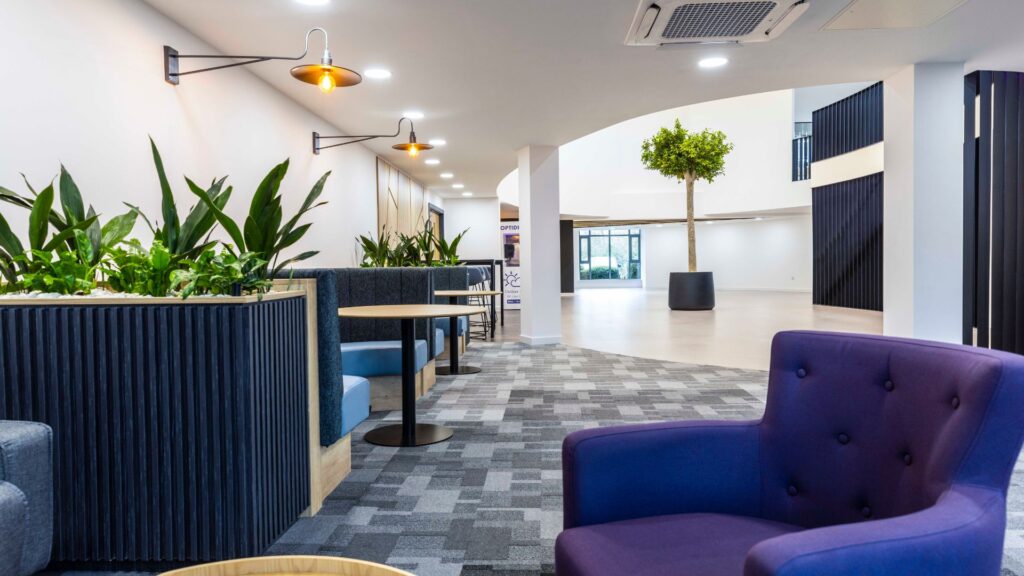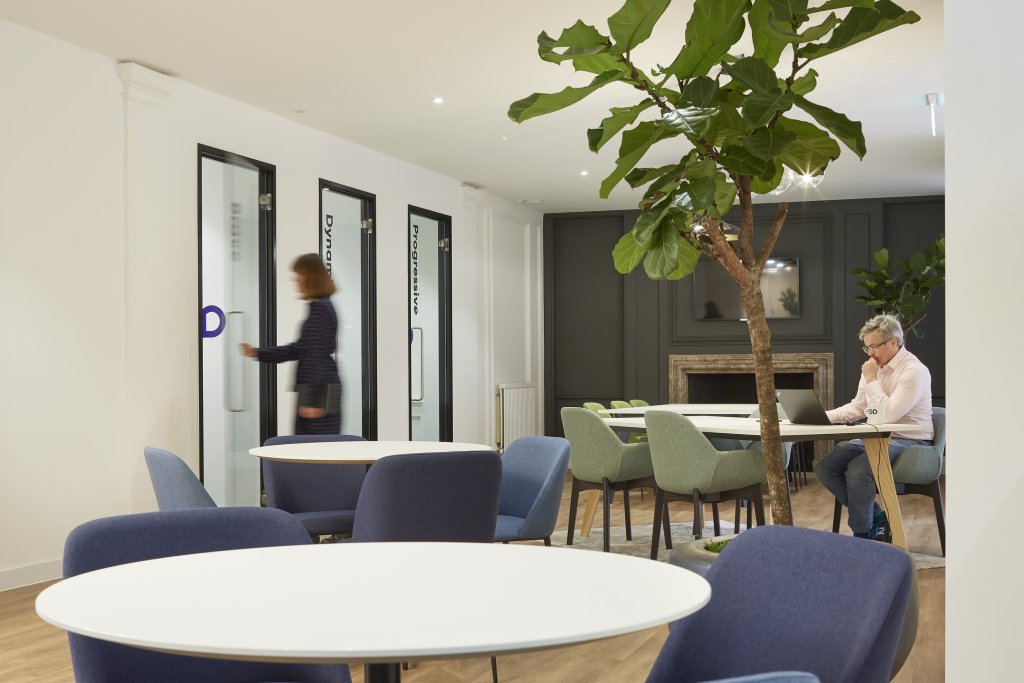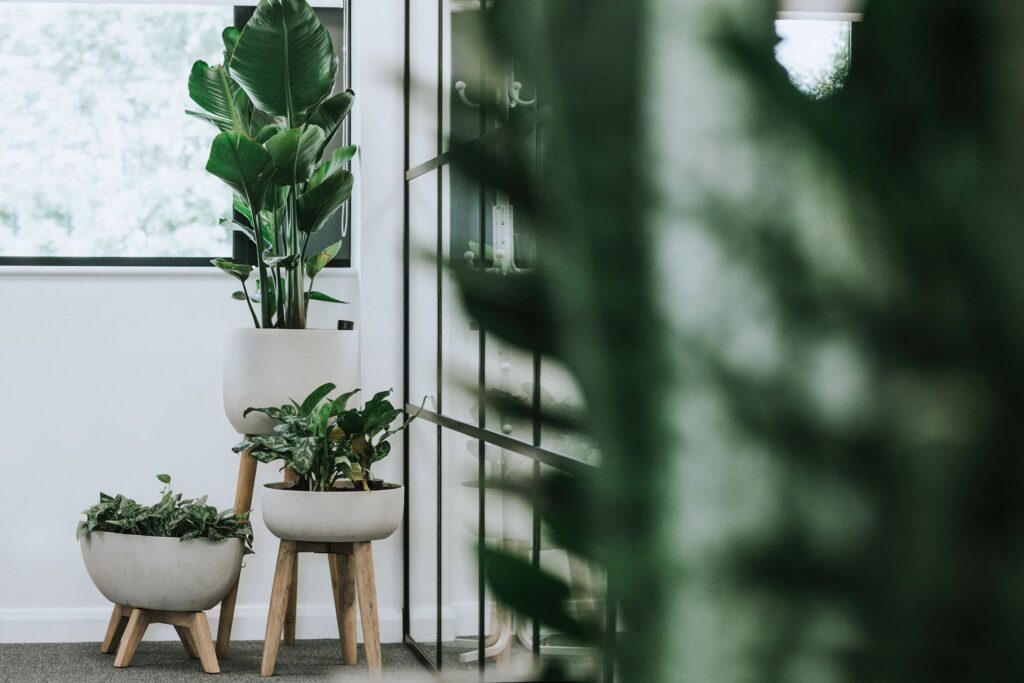Guest blog by Plant Plan
As humans, we have a deep-rooted connection to nature, and just like animals in the wild, the elements of the environment around us will directly impact our physical and mental health.
Paying attention to the parts of the environment over which we have control is a simple yet effective way to not only boost our mood but also aid creativity and concentration, and directly affect our performance at work. Incorporating touches of nature into our workplaces and offices is a great place to start.
But how is this incorporated into the workplace, why now, and what can we do to achieve this?

Moving on from the traditional open-plan office
As we move through the 2020s, it’s clear that the traditional office as we once knew it has become outdated, and employees want to continue to reap the benefits we discovered when the pandemic brought about nationwide remote working.
Instead of the desire to return to full-time office-based work, the popularity of remote working jobs continues to rise. Statistics from PWC’s Global Workforce Hopes and Fears survey suggest 62% of workers now expect hybrid working, and Google searches for the term ‘remote working jobs’ have increased by 23% over the past year. This upward trend indicates a growing interest in flexible, home-based work, despite the pandemic coming to a close.
Due to the continued demand for candidates seeking remote working, employers are taking measures to retain a team willing to come into the office a few times a week. One approach is to invest in office features that attract and retain staff, such as returning to nature and creating green, calm spaces, incorporating plants to improve overall well-being.
As a result, office planting specialists like Plant Plan have witnessed increased demand from workplaces since the pandemic, with offices looking to kit out their spaces with everything from desk plants to living walls. Employers are starting to recognise the benefits of incorporating plants to create office spaces that their staff enjoy and find conducive to work.
Traditional office spaces have faced criticism in recent years, with concerns that they may be outdated and have a negative impact on employee well-being. However, a new trend is emerging as companies strive to meet the changing expectations of their employees by creating social and comfortable workplaces.

So how can something as simple as plants support your workspace?
One of the most understated advantages of incorporating plants into office design is not just their visual qualities but the acoustic properties they present too.
Noise reduction- Plants can absorb and diffract sound waves, reducing overall noise levels in office environments. Their leaves stems, and branches can act as natural barriers, effectively dampening and diffusing sound.
In a study published in the Noise Control Engineering Journal, researchers investigated the potential of plants to reduce road traffic noise. The results suggested that a well-designed vegetative barrier, consisting of a combination of trees and shrubs, could reduce noise levels by 5 to 10 decibels. The study emphasised that the effectiveness of vegetation as a noise barrier depends on factors such as plant height, density, and distance from the noise source.
Plants have been found to be more effective in reducing high-frequency noise compared to low-frequency noise. High-frequency sounds have shorter wavelengths that are more easily absorbed and scattered by the irregular surfaces of leaves and branches.
Dense vegetation also provides better sound reduction compared to sparse plantings. Multiple layers of plants, with leaves at varying heights, create a more effective sound barrier by intercepting and diffusing sound waves at different levels.
Sound absorption – Plants with textured surfaces, such as large leaves or rough bark, can absorb sound waves, preventing excessive reverberation and echo in office spaces. This helps to create a more balanced and pleasant acoustic environment. The structure of leaves plays a role in sound absorption. Leaves with complex surfaces, such as those with rough or jagged textures, tend to absorb sound waves more effectively. For example, leaves with a rough upper surface and a downy lower surface can scatter and trap sound waves, contributing to sound absorption.
Background noise masking – Plants can help mask background noise in office settings by creating a soothing ambient sound. The rustling of leaves or the gentle sound of water features, such as indoor fountains, can help camouflage distracting noises and enhance overall acoustic comfort.
Improving speech clarity – Excessive noise and reverberation can negatively affect speech clarity in office spaces, leading to reduced productivity and increased stress levels. By reducing noise levels and reverberation time, plants can improve speech clarity, allowing employees to communicate more effectively.
Psychological well-being – Incorporating plants into office spaces has been shown to have positive effects on psychological well-being. Reduced noise levels and a more pleasant acoustic environment can contribute to lower stress levels, increased productivity, and enhanced overall job satisfaction.
Reduce visual distractions – Plants not only enhance acoustics but also provide visual barriers that can help reduce distractions in open office settings. By creating natural dividers or screens, plants can help to define spaces and provide privacy, promoting focus and concentration.
Design benefits – Emphasising the integration of natural elements in built environments, including plants, has been linked to various uses, including improved cognitive function, creativity, and overall well-being. By incorporating plants for acoustic improvement, office spaces can embrace these principles and create a more harmonious and productive atmosphere.

A more dynamic and greener open-plan
With a blended model of part office, part remote/home working becoming the accepted norm for most companies there is a quest by many responsible organisations to upgrade and improve their office spaces. The stagnant pre-pandemic offices that still linger in many parts of the UK are hardly a way to encourage your staff to put in more days in the office. So what is the better way to entice them in? Re-imagine the workplace. Soften the edges and make it less of the concrete jungle. Use more homely furniture pieces, paired with rugs and plants, which break up the once clinical, blank space to create a home from home feel for staff. Designing office spaces with this approach makes the time they spend in the office productive, beneficial and set in an environment people want to come and work in. Meaning that businesses can retain staff and avoid high turnovers while adopting a healthy working environment with a connection to the natural world.
Final thoughts
As we’ve seen, incorporating plants into office spaces brings a multitude of benefits beyond their beautiful appearance. Not only do plants add a touch of nature and charm, but they also serve important functional purposes. Picture this: a vibrant, green oasis amidst the hustle and bustle of the workplace. Plants create a visually appealing environment, but they also work wonders for office acoustics. By absorbing and diffusing sound waves, they help to reduce noise levels, creating a calm and peaceful atmosphere where concentration and creativity can thrive.
But it doesn’t stop there. The presence of plants goes hand in hand with improved well-being. Research shows that being surrounded by greenery in the workplace can lead to lower stress levels, increased productivity, and a greater sense of job satisfaction. It’s like having a breath of fresh air indoors! Additionally, plants act as natural dividers, providing privacy and reducing visual distractions in open office settings, allowing employees to focus on their tasks with renewed clarity.
So, let’s bring in the green and experience the positive transformation that plants can bring to our work environments. By embracing the power of plants, offices can create a dynamic and inviting workspace that combines productivity with a connection to the natural world. So, go ahead and introduce some leafy companions to your office – they’ll not only brighten up the space but also enhance the well-being and performance of everyone within it, plus did we mention they look really nice?
It All Starts With a Conversation
If you have a question, if you are looking for some bespoke advice, get in touch with our experts today, we’d love to hear about your project.
For a no-obligation chat about your office needs, complete the form below and one of our specialists will be in touch.
 Office
Office